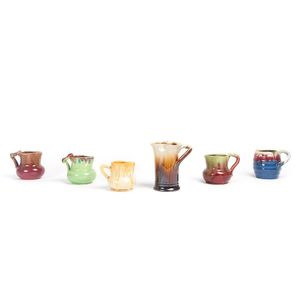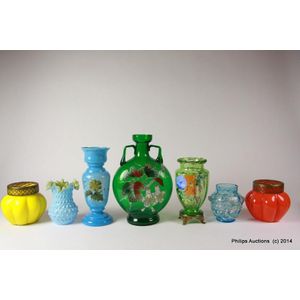Victorian and Czech Glass Vases and Bowls
You must be a subscriber, and be logged in to view price and dealer details.
Subscribe Now to view actual auction price for this item
When you subscribe, you have the option of setting the currency in which to display prices to $Au, $US, $NZ or Stg.
- Baluster (glass) - An architectural term for a column in a balustrade or staircase.
When used to describe glass, it can either refer to the shape of the stem of a wine glass, being slender above and pear shaped below, or the shape of the whole vessel, usually a vase. In fact the baluster shape is often described as being vase-like.
The description of a vase as being of baluster shape covers a wide variety of shapes that often bear no resemblance to the original architectural form. - Victorian Period - The Victorian period of furniture and decorative arts design covers the reign of Queen Victoria from 1837 to 1901. There was not one dominant style of furniture in the Victorian period. Designers used and modified many historical styles such as Gothic, Tudor, Elizabethan, English Rococo, Neoclassical and others, although use of some styles, such as English Rococo and Gothic tended to dominate the furniture manufacture of the period.
The Victorian period was preceded by the Regency and William IV periods, and followed by the Edwardian period, named for Edward VII (1841 ? 1910) who was King of the United Kingdom and the British Dominions and Emperor of India for the brief period from 1901 until his death in 1910. - Circa - A Latin term meaning 'about', often used in the antique trade to give an approximate date for the piece, usually considered to be five years on either side of the circa year. Thus, circa 1900 means the piece was made about 1900, probably between 1895 and 1905. The expression is sometimes abbreviated to c.1900.
- Japonaise - In 1853, Japan ended the long period of self-imposed isolation from the rest of the world and trade with Europe and America gradually developed. Impetus was given by the Meiji Revolution of 1867-8 which began the ruthless Westernization of Japan. As the Japanese enthusiastically embraced all things western, there was a corresponding appreciation of traditional Japanese art forms in the west. This led to traditional Japanese designs being incorporated into furniture, ceramics, and silverware in the third quarter of the 19th century.
Examples of the Japanese influence are Japanese motifs, faux bamboo, fretwork and lacquer work. - Stourbridge - Stourbridge in Worcestershire was an important glass-making centre from the 17th century, but production declined from 1745 with the introduction of the Glass Excise Acts which raised the price of raw materials for the English glass makers. The glass tax was abolished in 1845,
enabling the factories to compete with the long-established glassworks of Bohemia, many of the products of which were copied by the English manufacturers. Products included vases, scent-bottles, candle-sticks, plates, drinking vessels, and paper-weights, as well as large exotic one-offs reflecting the interest in the past, and prestige pieces, such as cameo glass. Manufacturers based in Stourbridge included Thomas Webb & Sons, Stevens & Williams and H. G. Richardson & Sons. - Bronze - An alloy of copper and tin, traditionally in the proportions of about 9 parts of copper to 1 part of tin.
The discovery of bronze in Western Asia in the 4th century enabled people to create metal objects which were superior to those previoulsy possible because of its strength and hardness, and it has been used throughout the world for weapons, coins, tools, statuary and other decorative items.
It is very fluid in a molten state, and its hardness, strength when set, and non-corrosive properties makes it most suitable for casting sculpture.
This item has been included into following indexes:
Visually similar items

Bendigo: group of five pottery vases in blue, green, turquoise & brown glazes. Heights 11.5 cm to 21 cm

Remued: group of six pottery jugs with branch handles, circa mid 1930s. Various sizes. Heights 7.5 cm to 13 cm

Two Mary Gregory cranberry vases and a jug, height 23.5 cm (tallest)

A pair of Royal Doulton 'Wild Rose' vases, 1947, also known as roses G pattern D 6627, the globular vases each with a broad trumpet neck, pattern 8025, decorated in amber, yellow, and maroon colours with green accents upon a mottled sky to deeper blue grou
